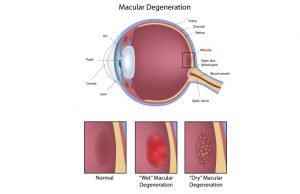Age-related macular degeneration (ARMD) is the most common cause of vision loss in people aged over 50 years old. The prevalence, (number of new cases each year), increases with age. It is caused by degeneration of the macula, the central, and most sensitive part of the retina at the back of the eye.

What is the Macula?
The macula is the central part of the retina which is responsible for enabling fine detail to be discerned. The remainder of the retina enables ‘peripheral vision’ only. Without the use of the macula, tasks like reading small print and recognising faces become are made difficult or impossible. The macula contains a yellow pigment (hence the term macula lutea). The disease becomes increasingly more common amongst people in their 60s and 70s. By the age 75, almost 15% of people have this condition to some extent. The biggest risk factor is thus age. Other risk factors are a family history of the condition, cigarette smoking, and being White Caucasian.
What are the types of ARMD?
There are two main types of ARMD often termed ‘Dry ARMD’ and ‘Wet ARMD’. The pathological process is different between the two. In the wet form, there is a proliferation of abnormal blood vessels under the macula. In dry ARMD, there is the collection of small yellow deposits within the retina called drusen, and degeneration (atrophy) of the retinal tissue at the macula. The dry form is more common, but the wet form is usually more sudden and devastating to the vision. See photographs below.
What Does ARMD Do To The Vision?
ARMD affects only the central area of the vision. Thus, this condition never causes complete blindness or loss of sight.
Is there any treatment for ARMD?
Currently, there is no cure for ARMD. The risk of developing ARMD can be reduced by not smoking. Studies have given us some evidence that a diet rich in antioxidants and certain pigments (found in dark green vegetables like broccoli and kale) may reduce the risk of progression of the disease process. For a very small percentage of ‘wet’ ARMD cases, a relatively new treatment called ‘Photo Dynamic Therapy’ (PDT) may be used to reduce the risk of further visual deterioration.





POST REPLY